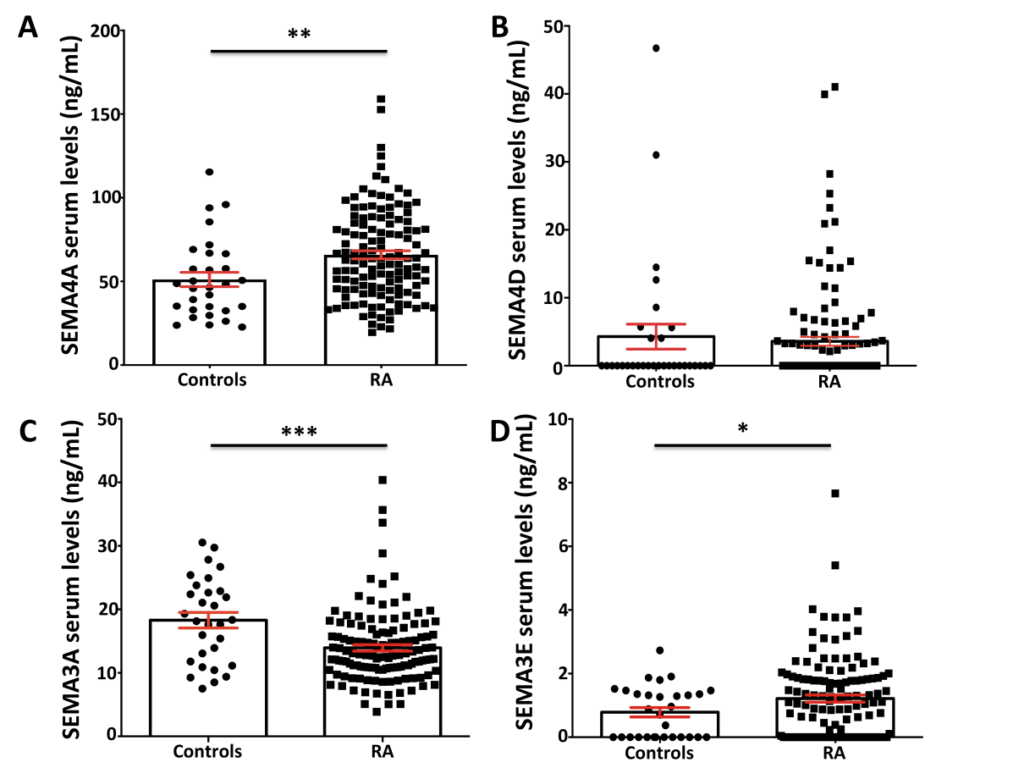FineTest Elisa kit contributes to the research on inflammation and rheumatology. The immunoassay is designed to measure SEMA3A concentration in serum.
Publication Details
Article Title: Semaphorins: From Angiogenesis to Inflammation in Rheumatoid Arthritis
Journal Title: Arthritis & Rheumatology
DOI: 10.1002/art.41701
IF: 10.995
PMID: 33605067
Abstract: Objective: To study the potential role of semaphorins in the pathogenesis of rheumatoid arthritis (RA). Methods: Microarray experiments were performed on Affymetrix GeneChip Human Exon 1.0 ST arrays in RA endothelial cells (ECs) and control ECs derived from circulating progenitors. Expression of class 3 and class 4 semaphorins and their receptors in the serum of RA patients and healthy controls was assessed by immunohistochemical analysis in synovial tissue and by enzyme-linked immunosorbent assay. Results: Microarray analysis revealed differential expression of class 3 and class 4 semaphorins and their receptors in RA ECs. Semaphorin 4A (SEMA4A), plexin D1, and neuropilin 1 messenger RNA (mRNA) levels were markedly increased in RA ECs by 1.75-, 2.21-, and 1.68-fold, respectively. Stimulation with tumor necrosis factor (TNF) led to a 2-fold increase in SEMA4A mRNA levels in RA ECs, and deficient SEMA4A expression modified RA EC angiogenic properties. Class 3 and class 4 semaphorins as well as their receptors were overexpressed in RA synovial tissue. A respective 1.30-fold increase and 1.54-fold increase in SEMA4A and SEMA3E, as well as a 24% decrease in SEMA3A, was observed in the serum of RA patients. Serum levels of SEMA4A, SEMA4D, and SEMA3A correlated with levels of inflammation and proangiogenic markers. In 2 independent cohorts of patients with low disease activity or with RA in remission, the presence of SEMA4A identified patients with residual disease activity. Conclusion: Gene expression profiling of ECs identified class 3 and class 4 semaphorins as potential biomarkers and therapeutic candidates in RA, with confirmed overexpression in ECs, synovial vessels, and serum, and correlation with validated markers of inflammation and angiogenesis. Thus, semaphorins might be novel and appealing EC-derived inflammatory and proangiogenic targets in RA.
Keywords: Arthritis, Rheumatology, Gene Expression Profiling, Inflammation, Neovascularization, Semaphorins
Immunoassay
| FineTest Product | Sample | Detection Target | Species |
| Human SEMA3A(Semaphorin-3A) ELISA Kit (EH2193) | Serum | SEMA3A | Human |
As illustrated in Fig. 4, SEMA3A serum levels inversely correlated with global arthritis score assessed by PDUS (r= - 0.22, P=0.022), CRP levels (r=-0.22, P=0.012) and with DAS28 (r=-0.18, P=0.042). No correlation was observed between SEMA3E serum levels and markers of inflammation.
Validated Image

Figure Source: Arthritis Rheumatol, 2021 Sep;73(9):1579-1588. doi: 10.1002/art.41701.
Figure 4A-D: Serum concentrations of SEMA4A (A), SEMA4D (B), SEMA3A (C) and SEMA3E (D) in patients with rheumatoid arthritis from the discovery cohort (n=130) and controls (n=30); All data are shown as the mean ± SEM. * p<0.05, **p<0.01, *** p<0.001 determined by Student’s t test.
